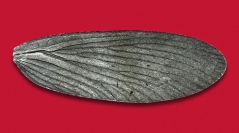

 Geodiversitas
47 (18) - Pages 705-712
Geodiversitas
47 (18) - Pages 705-712The insect family Parelmoidae Rohdendorf, 1962 belongs to the extinct order Diaphanopterodea Handlirsch, 1919, itself belonging to the larger taxon Megasecopteromorpha Béthoux in Yang, Ren & Béthoux, 2020. Although generally rare, representatives of this family are a typical component of Permian environments, particularly in the Cisuralian, with occurrence in renowned localities such as Obora, Elmo & Midco, and Chekarda. Here we describe a new Parelmoidae, Grandelmoa jingqii n. gen., n. sp., known from a well-preserved, isolated wing discovered from a new locality, named ‘Zhiyu’ (Shanxi Formation; Shanxi Province, China). The peculiar wing venation pattern of this new taxon is best explained by a translocation (as it is, of MP branches onto CuA), a phenomenon yet rarely documented among palaeopteran taxa. The new species occurs to be, by a small amount, the largest Permian Diaphanopterodea known to date.
Permian, Cisuralian, Palaeoptera, China, fossil insect, wing venation, vein translocation, new genus, new species